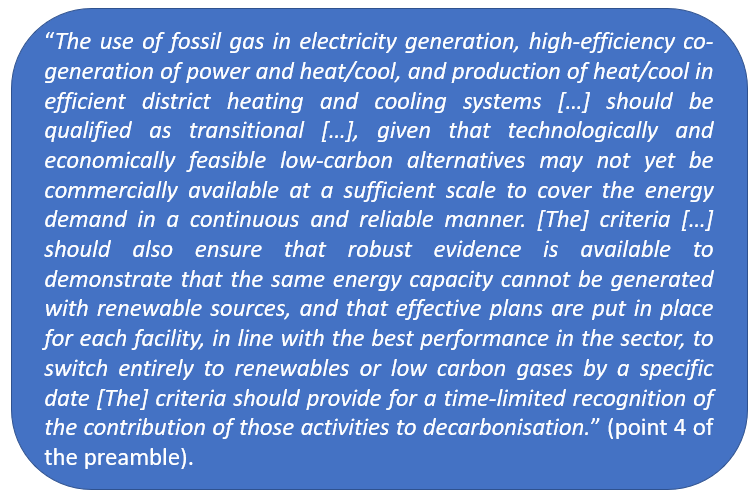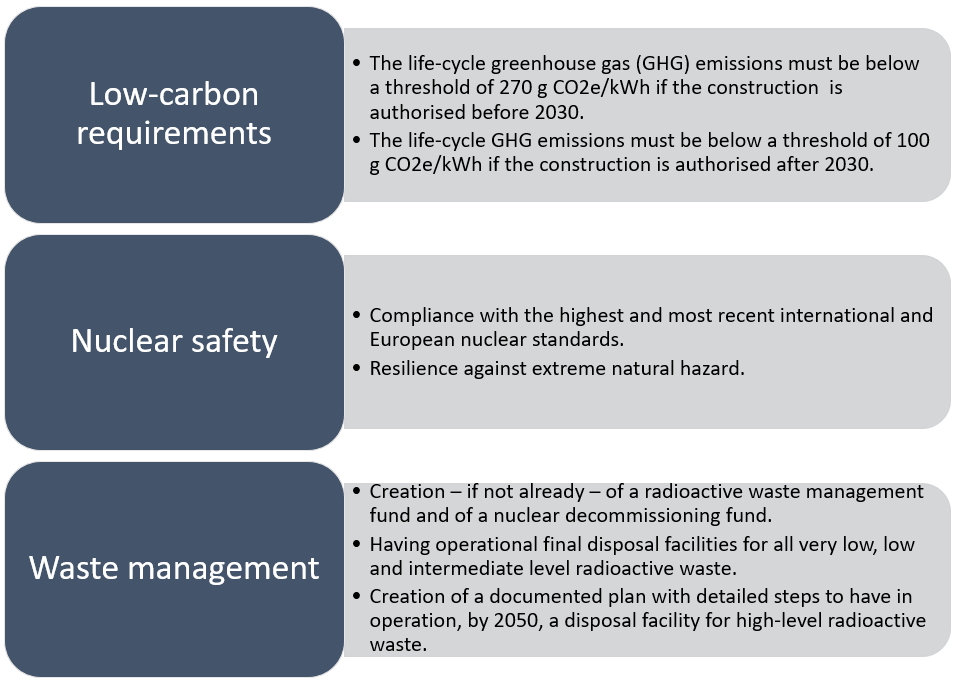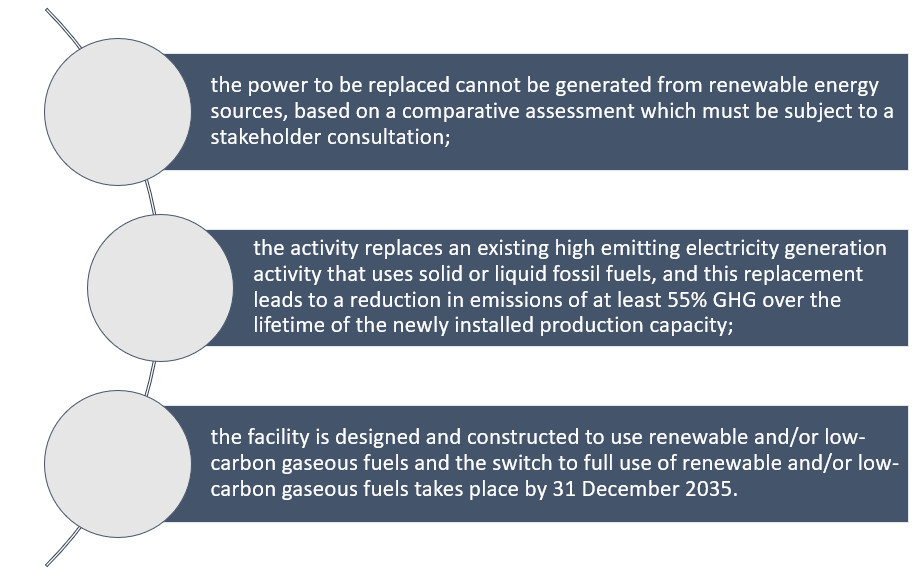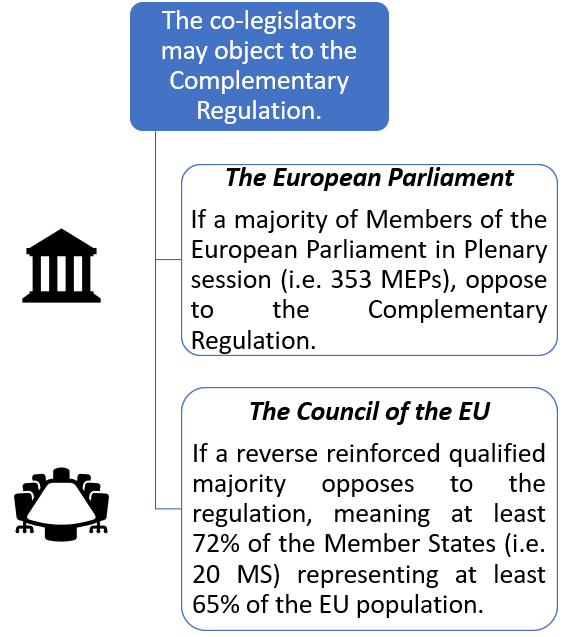Cet article est uniquement disponible en anglais. N’hésitez pas à contacter le cabinet pour tout complément.
This paper aims at analysing, from a legal perspective, the context and meaning of the inclusion of nuclear energy and natural gas within the European Union climate taxonomy. This is the second section of a two-part analysis. The first section, which may be found here, focuses more specifically on the context of the taxonomy.
The stakes surrounding the complementary climate delegated regulation (the « Complementary Regulation »), on nuclear energy and fossil gas
The previous delegated acts had postponed the nuclear energy and natural gas matters to a later time, waiting in particular for the review of the Joint Research Center’s technical assessment of nuclear energy with respect to the ‘do no significant harm’ criteria of Regulation (EU) 2020/852 (‘Taxonomy Regulation’).
Even before the adoption of the Complementary Regulation on 2 February 2022, heavy debates had already taken place at national and European levels. For instance, the French Senate published a report on the inclusion of nuclear power within the taxonomy, on 24 November 2021.
The debate has been – and is still – lively between Member States. Since the COP-26, Austria, Germany, Luxembourg, Denmark and Portugal have strongly opposed to nuclear power, while France Poland, Hungary, Czech Republic, Croatia, Bulgaria, Slovenia, Finland, Romania, Slovakia, Belgium, Estonia and Netherlands have supported this energy source at some point or another during the taxonomy negotiations.
Similarly, there are anti-natural gas countries, in particular Austria, the Netherlands, Denmark and Ireland, while several countries have supported natural gas, at least as a transitional energy source, among them Germany, Bulgaria, Croatia, Cyprus, Czech Republic, Greece, Hungary, Malta, Poland and Romania.
The political stakes are thus high, some countries supporting their nuclear industry and the choice of this energy to reduce their CO2 emissions, while others – and sometimes the same – countries support natural gas as a transitory solution from coal to renewable energy.
Unfortunately, the rationale and the clarity of legal documents resulting from political – sometimes contradictory – compromise are rarely ideal.
The content of the complementary climate delegated regulation, on nuclear energy and fossil gas
The European Commission summarized as follows the Complementary Regulation on these two energies:


There is not much debate about the contribution of nuclear power to the fight against climate change, the latter being mostly related to the carbon level in the atmosphere and nuclear plants being relatively low-carbon facilities. The question is more complex for natural gas power plants, although they emit significantly less CO2 than coal – between a half and a third, or even less with improved processes – and are thus seen as a transitory solution by countries which may not otherwise easily replace coal.
But the heart of the debate is elsewhere. Does the support of these energies:
- hinders the development of more sustainable solutions such as renewable energy sources?
- comply with the “do not significant harm” (or “DNSH”) criteria?, i.e. whether these energies, while contributing significantly to one of the six environmental objectives, simultaneously significantly harm one or several of the five other objectives.
The conditions for the inclusion of nuclear power and fossil gas within the EU Taxonomy are summarized by the European Commission in the preamble of its Complementary Regulation. They are detailed in its annexes which may be found here, in particular annex I related to the climate change mitigation objective.
Without being exhaustive, the main constraints concerning nuclear power are:

While the main constraints applicable to fossil gas are – again without being exhaustive:

In any case, both energy sources are considered transitory in the EU Taxonomy. A nuclear power plant may only be financed by green bonds if its construction is authorised by the end of 2040 (for modified plants) or by the end of 2045 (for new plants). Similarly, fossil gas power plants may only be financed by green bonds if they are authorised by the end of 2030.
Obviously, these time constraints may change in the future: the regulation may be amended through the same process either to extend or to reduce the inclusion of these energies within the EU Taxonomy, or even to remove them.
Finally, the Complementary Regulation specifies that even if the activities comply with the above criteria, the green financial products and bonds shall mention whether they finance nuclear power or fossil gas. The investors are thus made aware of this information, although the “green” qualification remains.
Is this the final version of the complementary climate delegated regulation and when will these provisions be enforced?
The draft published on the 2nd of February may not be the final version of the Complementary Regulation.
As explained by the European Commission, it is currently under scrutiny by the co-legislators, which are the European Parliament and the Council of the EU (i.e. the institution gathering the Ministers of the Member States). The period of scrutiny is four months and may be extended by two months at the Parliament or Council’s request.

If the co-legislators do not raise objections under the above conditions, the Complementary Regulation will be final at the end of the four-month period – as the case may be extended for two additional months. It will then be published.
If the co-legislators do raise objections, a new version of the act may be proposed by the European Commission, or it may be withdrawn.
Finally, the date of enforcement provided by the Complementary Regulation is 1 January 2023.
Final words
Numerous Member States are relatively satisfied with a compromise that includes both nuclear power and fossil gas within the EU Taxonomy, under specific conditions. Gathering a reinforced qualified majority at the Council is thus unlikely, whether for anti-nuclear or anti-fossil gas countries.
Absent this political recourse, Austria has threatened to introduce an action for annulment before the European Court of Justice against the Complementary Regulation, in order to challenge – at least – the inclusion of nuclear power within the EU Taxonomy.
These debates illustrate the fragile balance between the protection of the environment and the fight against climate change on the one hand, and the right of Member States to determine their energy mix, set at Article 194 of the Treaty on the Functioning of the European Union, on the other hand.
The restriction of the access to financing would obviously be critical to all energy sources, but it is worth remembering that the energy mix remains Member States’ sovereign choice and the national debates thus retain their full relevance in spite of the inclusion of nuclear power or fossil gas within the EU Taxonomy.
Retour aux articles